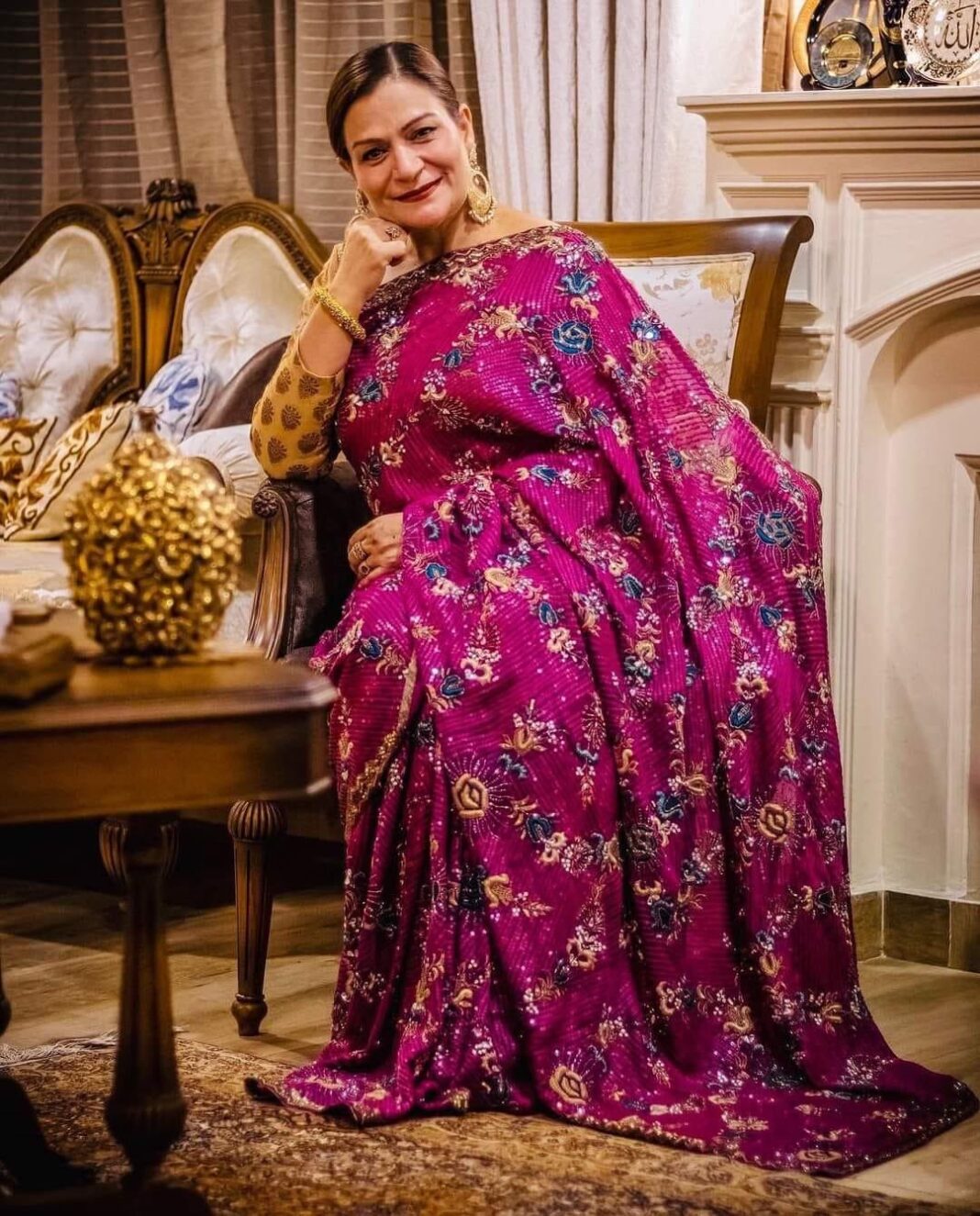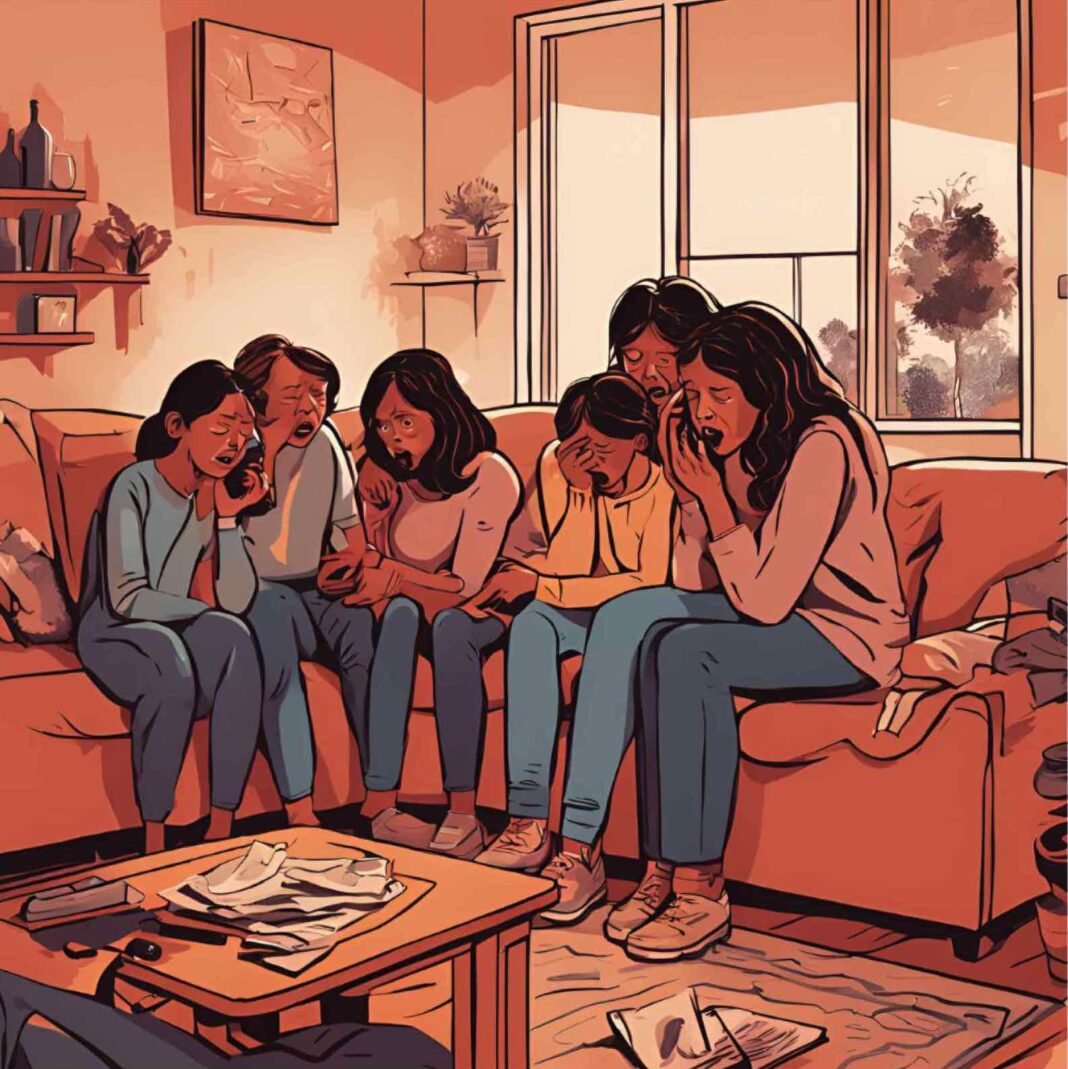By NAZIR GANAIE
New Delhi, Nov 15: In a world where dreams are often confined to the practical, Samina Bashir or Samina Khan is a vibrant testament to the power of following one’s heart. A woman who defied convention and carved a unique niche in the fashion industry, Samina’s story is not just about sartorial brilliance but also about courage, reinvention, and an unyielding desire to live life on her own terms.
The Beginning of a Dreamer’s Journey
Samina Bashir was never the type to follow the prescribed path. With a science degree in hand, she effortlessly floated into the Department of Law at University of Kashmir—drawn not by the allure of legal briefs, but by the department’s aesthetic charm. Her choice was simple: she would always follow her heart, no matter where it led her. As a young woman with a dreamy disposition, she saw life through rose-colored glasses, a lens of optimism that guided her journey from the classroom to the courtroom and, eventually, to the world of high fashion.
Her time at law school, followed by a Bar Council license, did not dampen her desire for something more—something creative. It was clear early on that Samina was meant for a different kind of expression.
“I had a passion for fashion,” she recalls. “Even when I was in school, I would design my own uniforms. The standard white attire everyone wore seemed so mundane—I needed to make it my own. A natural flair for design blossomed early, and it wasn’t long before she turned her attention to the world of textiles and garments.”
A Leap of Faith: From Courtrooms to Couture
Samina’s big break came when she decided to take a leap of faith, leaving the secure, predictable world of law behind. “I wanted to be my own boss,” she says with conviction. “I needed the freedom to create, to be in charge of my own destiny.” And so, in her newfound apartment in Delhi, she hosted a small exhibition of Kashmiri embroidery—a collection of garments stitched with rich, traditional artistry. The response was overwhelming, and orders began flooding in.
This early success paved the way for Samina to transform her passion into a business. Her exhibitions, a fusion of Kashmiri artistry and modern design sensibilities, became highly anticipated events in the fashion calendar. In fact, she made history when, 24 years ago, she held the first-ever exhibition of designer wear in Srinagar. The event was a turning point, and it was there that she realized her potential for greatness.
“Those early years in Srinagar were formative,” she says, reflecting on the courage the city gave her to think beyond the horizon. “It wasn’t just about showcasing clothes; it was about bringing a new perspective to Kashmiri craftsmanship. That’s when I truly believed that I could make a difference.”
The Birth of a Brand ‘Saminakhan’s Couture’
In 2014, Samina took the next bold step and opened her flagship store on Lambert Lane, Srinagar. But fate had a different plan. On the very first day of its launch, disaster struck—the devastating floods of Kashmir washed away everything. The blow was massive, but Samina’s resolve was unshaken. She returned the following year, rebuilt her store, and within no time, was back on top. However, as political unrest once again shook the region, Samina made the difficult decision to move her operations to Delhi. The bustling streets of Shahpur Jat in New Delhi became her new creative haven, nestled within one of the city’s largest fashion hubs.
“Delhi taught me the essence of high fashion,” Samina explains, “but I never lost sight of my roots. I kept the Kashmiri embroidery alive in every piece I designed.”
In the heart of Shahpur Jat, amidst the vibrant hum of artisans’ hands stitching magic into fabric, there lies a story of rebellion, resilience, and a relentless pursuit of craftsmanship. A tale that begins not with a thread or a needle, but with the struggle of a woman determined to create her own space in a world that told her she didn’t belong
For Samina Khan, textiles were never a passing interest. From a young age, the soft whisper of handwoven fabrics, the intricate dance of hand-embroidered stitches, and the luxurious sheen of pure Banarasi silks spoke to her in a language no law degree could translate. “Law was never my cup of tea,” she says, recalling the pressure of a family steeped in tradition—where no woman, no matter how educated, was expected to work. But she fought her way through, refusing to let the chains of conservative expectation hold her back. “I had to work harder, not just for my own independence, but to show my daughters that they could aspire for anything. To empower them to believe in themselves, to strive for their ambitions.”
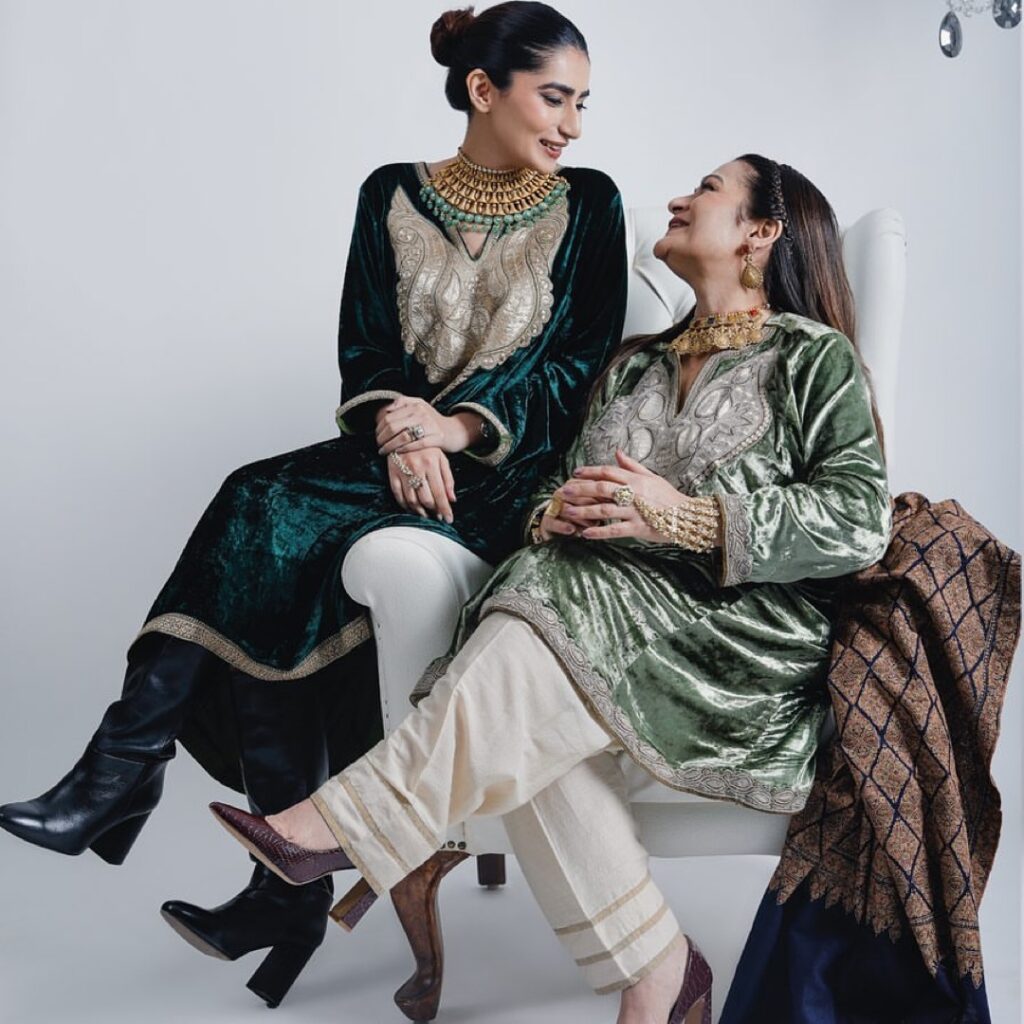
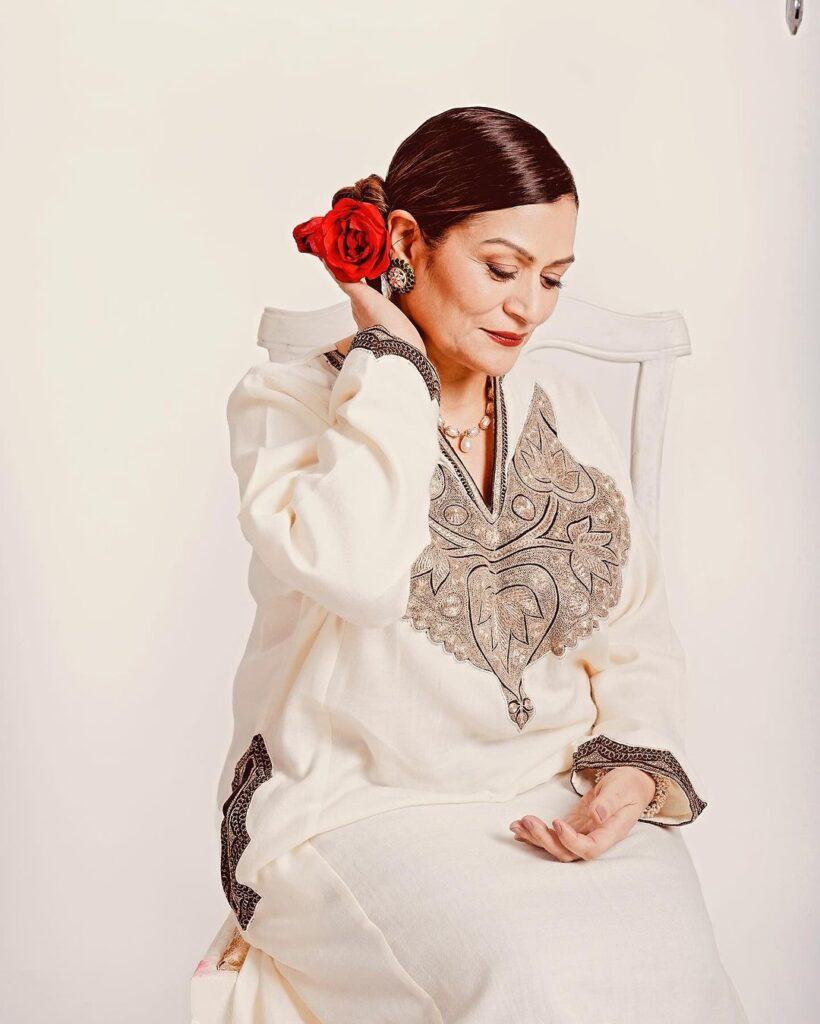
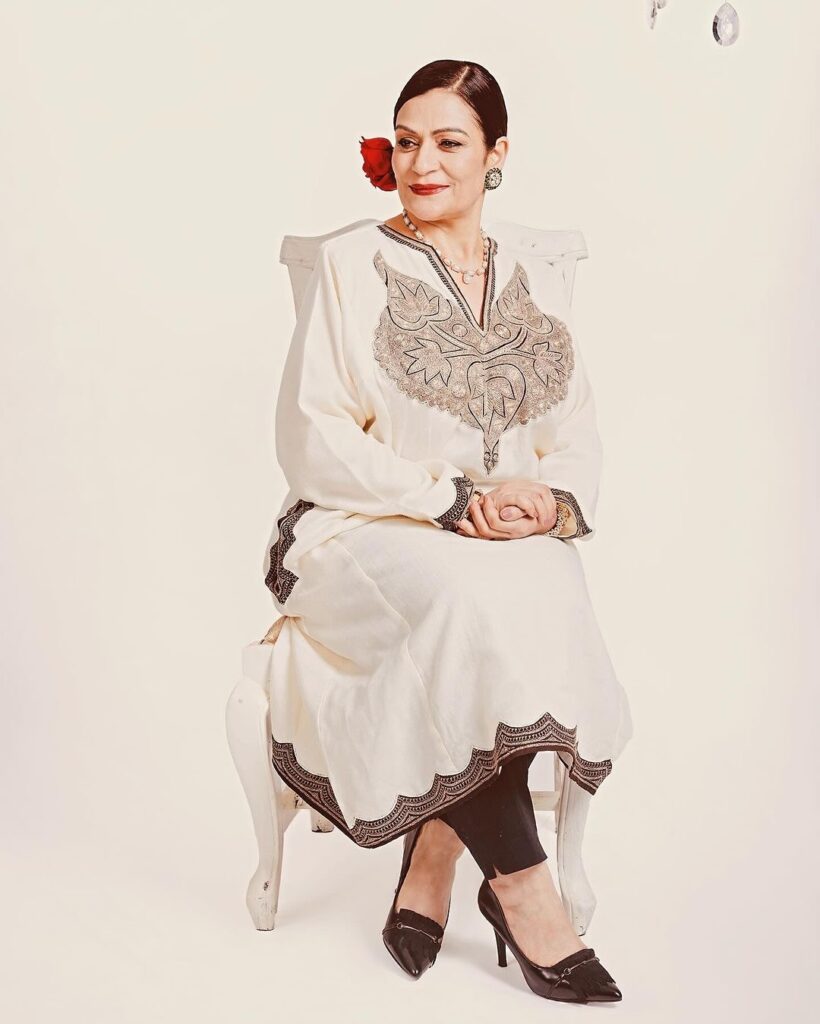
In a society that often feels like it’s constantly reinforcing boundaries, Samina Khan turned those very limitations into the canvas of her creativity. She broke free from the confines of what was expected of her and found solace in her first love: textiles and design. “I’m a hardcore lover of the art of pure fabrics. I can literally smell them from a distance,” she says with a twinkle in her eye, as though she’s still in awe of the magic she’s able to create through the tactile beauty of fabric.
It was this love affair with fabric—handcrafted, handwoven, and hand-embroidered—that led her to establish her workshop in the bustling lanes of Shahpur Jat. Here, in the company of artisans, she brings her vision to life. “To watch my hand-embroidery artisans weave magic is absolutely fascinating. It’s like watching a piece of history being created right before my eyes,” she says, a sense of pride evident in her voice. The intricacies of tilla work, sourced from Kashmir’s timeless designs—sometimes from the very pherans worn by her grandmother—are the cornerstones of her creations. “I have a roving eye, always searching for the embroidery we’ve lost with time, the designs that tell stories.”
This passion for preserving the past while forging a new future through design has shaped her philosophy of fashion. Samina Khan’s creations are an amalgamation of tradition and innovation. She fuses Banarasi kham khwab and tanchoi handwoven fabrics with the opulence of tilla work, creating gowns that deviate from the norm, offering something truly unique. “Amalgamation of art is art itself,” she declares, revealing a mindset that refuses to follow trends and instead crafts them.
Her work has traveled far and wide—exhibiting in renowned platforms from the United States to Kashmir, with memorable showcases in Buffalo’s KGNA, San Francisco, and LA. In Delhi, too, her collections have graced some of the most prestigious venues. Yet, for all the international acclaim, it’s the meticulous work done by her team of artisans that remains at the heart of her brand.
“It’s not just about the fabric; it’s about the soul that goes into each piece,” she explains. The clientele she serves is not interested in ready-made, mass-produced garments. They come to her for what is rare, what is timeless, what is crafted with precision and care. “People with finer tastes seek the best. Ready-made, run-of-the-mill fabrics are for those who don’t believe in class,” she says with conviction. “What we have, you won’t find anywhere else.”
Over the years, her clients—many of whom have been loyal for decades—have come to associate her brand with luxury, legacy, and lasting quality. “People remember my work from decades ago, and that’s something I’m immensely proud of,” she says. In a world of fast fashion, her pieces stand as a testament to enduring beauty, sophistication, and the legacy of craftsmanship.
And perhaps the most rewarding part of her journey? Empowering the next generation. “I’m proud to be a part of their good fashion and better grooming,” she says, knowing that the taste for true artistry is something that’s passed down, generation after generation.
In the world of high fashion, where trends often come and go, Samina Khan has built something that isn’t just a brand—it’s a legacy. And it’s a legacy founded on the belief that no woman, no matter her circumstances, should ever have to choose between her dreams and her reality.
A New Chapter: The Rise of Samina and Sophiya Khan
In the years that followed, Samina’s work gained international recognition. Her designs, rich in heritage yet strikingly modern, garnered clients from all over the world. Yet the most significant evolution came when her daughter, Sophiya Khan, joined the brand, adding a fresh dynamism to the business. “Sophiya brought a new energy, a new perspective,” Samina says with a proud smile. “She’s helped elevate the brand and bring it into a new era.”
Under their leadership, Sam’s Designers has become synonymous with high-quality, intricate Kashmiri tilla work, as well as a revived love for handwoven Banarasi textiles—traditional fabrics that had long been forgotten. Samina and Sophiya’s innovative approach to blending vintage embroidery with contemporary design has won them acclaim on international platforms, including a notable exhibition of their work in America.
“I believe in giving vintage embroidery a new lease of life,” says Samina. “It’s all about infusing these ancient techniques with color, energy, and a sense of modernity that resonates with the global fashion sensibility.”
Talking about her co-designer and daughter, Sophiya, Samina Khan reflects on the deep-rooted connection Sophiya has with Kashmir, despite being born and raised in Delhi. “Though she was born in Delhi, her soul is deeply rooted in the traditions of Kashmir,” Khan says. “In her, the distance between the two places—geographical and cultural—fades into irrelevance. From the very beginning, she carried the heart of Kashmir with her, a heart that beats in the delicate patterns of crewel embroidery, in the vibrant colors of Pashmina shawls, and in the timeless motifs that have defined Kashmiri art for centuries. No matter where she grew up, she remains, in every sense, a true Kashmiri.”
Khan speaks proudly of their decade-long collaboration: “We have worked together for the last ten years, and in that time, Sophiya has not only learned the intricate craft of our art forms, but she has also made them her own.” She continues, “She has absorbed the skills, the techniques, and the philosophies that are at the core of Kashmiri design. But what makes her journey even more remarkable is the way she has embraced the responsibility of bringing these traditions to a younger generation. She’s worked tirelessly, blending the old with the new, making sure that the youth—both in Kashmir and beyond—are exposed to, and inspired by, the timeless beauty of their heritage.”
For Samina Khan, Sophiya’s contributions have been transformative. “In an age where trends often come and go, Sophiya has managed to carve out a space where the designs of Kashmir are not only revered for their tradition but celebrated for their relevance in the contemporary world,” Khan says. “She’s brought forth designs that speak to the youth—not as a distant, inaccessible tradition, but as a vibrant, living part of their identity. Her work tells a story of cultural continuity and innovation, bridging the gap between the past and the future with every stitch, every pattern, every creation.”
Sophiya’s approach to Kashmiri design has been one of evolution, not mere replication. “She has never been content to merely replicate what has come before,” says Khan. “She has understood, perhaps better than anyone, that Kashmiri design isn’t just about preserving the past; it’s about making sure it survives, evolves, and thrives.” Khan adds, “She has worked with dedication to ensure that these designs are not only for the collectors or the connoisseurs but for a broader audience—a younger, more dynamic generation who need to see these arts as part of their everyday lives, not just as museum pieces or historical artifacts.”
What stands out in Sophiya’s work is her profound connection to Kashmir, a place she may not have lived in but whose essence remains deeply ingrained in her. “What makes her story even more inspiring is her deep connection to the land and the people of Kashmir,” Khan says. “Though she has spent most of her life in Delhi, her identity remains inseparable from Kashmir. Every design she creates is infused with a sense of belonging, a sense of pride in her heritage, and an unwavering commitment to seeing Kashmiri craftsmanship thrive in the modern world. She embodies the spirit of Kashmir: resilient, graceful, and ever-evolving.”
Reflecting on their journey together, Samina Khan acknowledges Sophiya’s role in transforming not only her own craft but also the wider perception of Kashmiri design. “In working with Sophiya, I have seen the transformation not just of her craft, but of the wider perception of Kashmiri design,” she says. “She has shown that these ancient skills can flourish in today’s fast-paced world, not by abandoning their roots but by adapting them to the changing times. Her journey, her dedication, and her work are a testament to the power of heritage, creativity, and the indomitable will to ensure that the beauty of Kashmir is not just preserved—but reimagined for the future.”
A Global Reach, A Timeless Legacy
With clients spanning the globe, from the United States to Europe, Samina Bashir’s designs are not just garments—they are cultural statements, woven with the history and artistry of Kashmir. Despite the global expansion, Samina remains deeply rooted in the values that defined her journey: courage, authenticity, and a relentless pursuit of passion.
“I’ve always set my priorities right,” she reflects. “I knew what I wanted to do, and I’ve always pursued my dreams with conviction. Fashion is not just about clothes; it’s about telling a story, about making people feel something. And that’s what I aim to do with every piece I create.”
As Samina continues to push boundaries and redefine the landscape of Kashmiri couture, her brand’s legacy is already being written. A woman who dared to follow her dreams, no matter where they took her, Samina Bashir is not just a designer—she’s a cultural ambassador, breathing new life into an ancient craft and carrying it into the future with grace, creativity, and relentless determination.


